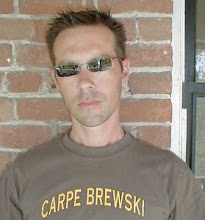Those of you who enjoyed reading about my bathroom renovation project during the autumn of 2006 may be in for a real treat as I turn my eyes toward our unfinished attic. My goal is to determine the feasibility of converting it into a functional living space that would serve as a bedroom.
The first order of business is to clean up some 102 years worth of dust and to create strong, well-defined walking paths to help prevent anyone (say a contractor or myself) from crashing through the non-existent “floor” during subsequent inspections. Tomorrow I need to hang some brightly colored flagging tape in the areas right before where I’ve been crashing head first into the rafters while concentrating on proper feet placement.
As it currently stands, the only access to the original attic is through a small hole cut into the roof. That portion of the roof was encapsulated within an addition that I believe dates to the 1920s. I can access that portion of the attic through a tiny trap door in the ceiling of our diner room. Two smaller attic areas resulting from later additions (40s and 50s?) are also present within the space. It is a real mishmash of rooflines, construction debris, and a jungle of old and new electrical wiring that would have made Nikola Tesla’s hair stand on end. The space probably should be cleaned up no matter what in order to help prevent termites from ever feeling welcome. Clearly too low for comfortable living spaces, those pockets still could provide an amazing amount of storage.

Not wanting to climb over the ductwork for our swamp cooler to access the main attic area, I set about creating a new “doorway” by removing the old wood shingles from the original roof, and cutting away sections of spaced sheathing between two rafters. It is still a tight squeeze, but if you can fit through the trap door in the ceiling, this is a slice of cake. To give you an idea of the size of the trap door, it is too small for my 10-gallon shop-vac to fit through. Luckily, I was able to remove the single window on the front of the house and pull the shop-vac up and through (in pieces).

It is very interesting how easily the old wooden shingles crumble in my hands. It is even more frightening to see how quickly they burn. Another great reason to get them out of the attic!
At first glance, and not knowing anything about the process, I estimate that there is enough space up there to at least proceed with the process. There are also a few issues that could possibly be addressed by a well-planned remodel. For instance, at some point in time, it appears that a large tree (I assume one of those hideous Chinese Elms that dot the neighborhood) crashed into the roof and damaged a couple of rafters. Possibly, that area would be a good choice for the location of a dormer. Quite possibly, having the ability to show existing damage that should be repaired would go provide a good starting point when explaining any proposed project to the historic buildings commission. I’m quite sure that they would have to approve the addition of something such as a dormer or even a skylight.
I know they sometimes offer tax credits to refurbishing historic structures, but I’m not sure if that includes just repairing a roof. Obviously that is something else to check into before making any decisions.
Watch for more exciting updates in the near future!



